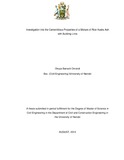| dc.contributor.author | Okoya, Barrack Omondi | |
| dc.date.accessioned | 2013-10-25T11:47:44Z | |
| dc.date.available | 2013-10-25T11:47:44Z | |
| dc.date.issued | 2013-08 | |
| dc.identifier.citation | Master of Science in Civil Engineering in the Department of Civil and Construction Engineering, University of Nairobi, 2013 | en |
| dc.identifier.uri | http://erepository.uonbi.ac.ke:8080/xmlui/handle/123456789/57897 | |
| dc.description.abstract | The aim of this study was to investigate the cementitious properties of the
product resulting from a mixture of rice husk ash (RHA) and building lime.
Chemical analyses were done using Gravimetric and Atomic Absorption
Spectroscopy, while particle size distribution of RHA carried out using
hydrometer analysis. Concrete mixes containing different proportions of
lime:RHA binder were cast. The binder was made by replacing lime with RHA
at intervals of 20% and reducing the interval to 10% closer to the optimum.
The same binder: sand: ballast mix proportions of 1:2:4 respectively at a
constant 0.5 w/c ratio was used in all concrete mixes and subjected to air and
water curing at room temperature. Workability tests were performed on all the
concrete mixes. Standard consistency, initial and final setting times, and
mortar compressive strength of the optimal blend were established.
Characteristic compressive and tensile strength of optimal lime:RHA concrete
were determined and the results compared with those of Portland Pozzolana
Cement (PPC) concrete and cost analysis carried out.
Results show that RHA has high silica content (more than 70%). Workability
was found to reduce with increase in RHA content in the mix as indicated by
reduction in slump values from 10mm to 2mm and reduction in compaction
factor values from 0.78 to 0.69. For concrete samples cured in air the optimal
blend was at 50% lime with 50% RHA while for water cured samples was at
30% Lime and 70%RHA. Initial and final setting time of the optimal lime:RHA
binder was found to be 285 and 1485 minutes respectively, its 28 day mortar
compressive strength was 7.07 N/mm2. Mean compressive and tensile
strengths of optimal lime:RHA concrete were found to be 10.83N/mm2 and
1.49 N/mm2 respectively while that of PPC concrete was 20.08 N/mm2. The
overall cost of the lime:RHA binder and hence the concrete was found to be
less than half compared with an equivalent concrete grade made of PPC. | en |
| dc.language.iso | en | en |
| dc.publisher | University of Nairobi | en |
| dc.title | Investigation into the Cementitious Properties of a Mixture of Rice Husks Ash with Building Lime | en |
| dc.type | Thesis | en |
| local.publisher | Department of Civil and Construction Engineering | en |

